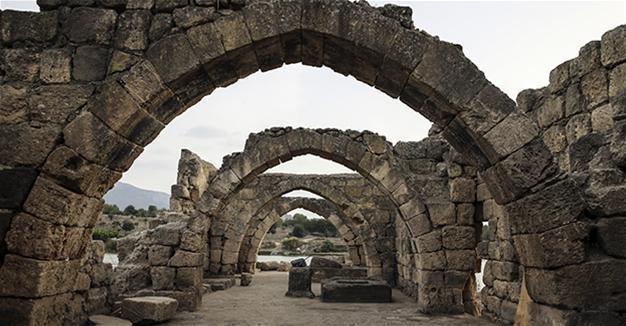Windmills of Misis comes to light
ADANA – Anadolu Agency

AA photo
Archaeological works are continuing to unearth Roman-era windmills in the ancient city of Misis, an important Roman-era city, as part of a project titled “The Infinite City: Misis” done by Yüreğir Municipality in the southern province of Adana.
The city is located right next to the Ceyhan River, 27 kilometers east of the center of Adana on the historic Silk Road.
In collaboration with the head of the excavations, Professor Anna Lucia D’Agata of the National Research Council of the Institute for the Study of the Ancient Mediterranean, and Pisa University Professor Giovanni Salmeri, excavations have been continuing for four years in the 7,000-year-old Misis, which is one of 270 archaeological ancient sites in Adana.
The castle, ancient theater and historic Roman-era Misis windmills on the River Ceyhan are being unearthed during excavations.
Yüreğir Mayor Mahmut Çelikcan said works in the ancient city of Misis started in 2012 and the restoration of the caravanserai as well as the reconstruction of the Lokman Hekim Mosque finished during the process.
He said works still continued to revive two second- and third-century windmills. “We will also focus on the castle structures, which date back to the late Hittite era and was discovered during this year’s works. Prior to these works, the city was believed to date back 3,000 years ago but after the excavations, experts stated that its history dates back to 7,000 years ago.”
The mayor said a culture park would be restored after the restoration of the windmills. “Visitors will be able to see these historical beauties. As the excavations progress and remains are discovered, this place will turn into an archaeological park,” he added.
Important to understand southern history
D’Agata said the ancient city of Misis had been a settlement since the Neolithic Age and that surface surveys had revealed settlements from the Neolithic Age to the Iron Age in the Misis Mound.
She said the city was abandoned at the end of the eighth century after the expansion of the Assyrians.
“Misis developed and expanded in the age of the Middle Kingdom. In this era, the city covered some 80 hectares, including a wide necropolis of rock tombs. It was a border castle that changed hands numerous times until the end of the 14th century. When Sultan Mehmet IV built a caravanserai on the river in 1661, the city gained importance,” she said.
Salmeri said they discovered remnants from the Neolithic, Chalcolithic, early Hittite, Roman and Byzantine periods in the ancient city.
He said the River Ceyhan played an important role in history. “Misis was a communications center. It was very important in the Roman era. We know that there was a theater, stadium and a square in those years.
We also know that Misis had experienced wars. Understanding the history of Misis was important to understanding the history of Turkey’s southern part.”
The project, “The Infinite city: Misis,” includes the construction of a new housing project by the Housing Development Administration of Turkey (TOKİ). Agricultural activity will continue in the area, but not at the excavation site itself, and a set of incentives will be offered to local farmers by the Agriculture Ministry, permitting daily life to continue at Misis.
